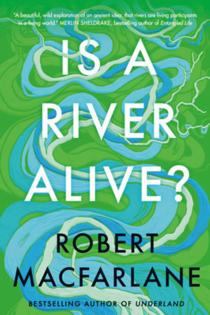Review: 'Is a River Alive?' explores what we should learn from rivers
Published in Books News
We Minnesotans are almost all lucky enough to live near a river. The Mississippi, Minnesota, Red, Pigeon, Cascade, Crow, St. Croix, St. Louis, Whitewater, Zumbro and thousands of other waterways flow through our state.
Rivers have shaped our landscape, economy and history. Through the eons, humans have worshiped them, abused them and sometimes saved them. Rivers run through our art and our dreams. Who among us has not sat by a river to contemplate its mysteries?
Well then. Are rivers alive?
The great British nature writer Robert Macfarlane (“Underland,” “Mountains of the Mind,” “The Old Ways”) embarks on a series of often harrowing journeys on three very different rivers to explore that question in “Is a River Alive?”
In the first, he travels high into a remote, dripping, emerald-green Ecuadorian cloud forest to the headwaters of Río Los Cedros, a pristine place imperiled by voracious mining companies. Next, in the poor, densely populated Indian city of Chennai, he explores the scattered, polluted waterways that were once part of a mighty river. Finally, he undertakes a life-threatening journey on the Mutehekau Shipu (Magpie River) in Canada’s far northeast, a wild land that some want to tame with dams — creating reservoirs, which Macfarlane calls “the graves of rivers.”
For Macfarlane, each trek is fueled both by science and a sophisticated mysticism. In acrobatic prose, he describes the habitats and humans that call those waterscapes home, as well as the quixotic preservationists who have fought to save them from ruin with “Rights of Nature” legislation and litigation that often originate with Indigenous people.
Yes, but … are rivers alive? In almost all senses of that word, he believes, the answer is yes. Certainly, we know when a river is dead, he observes wryly.
A healthy river contains multitudes of life forms that rely on it. It is ever restless, shaping its environment. It breathes, and it can be choked. A watershed map resembles one of our own veins or neurons. And when we come to deeply know a river, we learn its powers, its moods, its vulnerabilities. Ancient people worshiped rivers; modern humans have sought to harness them. Macfarlane argues for a whole new — or perhaps a very old — way of looking at rivers.
“Strong forces will be required to release older, more complex river-meanings from their impoundment — and to reanimate our relationship with these vast, mysterious presences whose landscapes we share,” he writes.
Perhaps the most moving and beautiful part of his book comes in the interludes between visits to faraway rivers in which Macfarlane tells the history of a small spring near his home in Cambridge, England, and of how human habitation, from prehistory to recent drought years, has shaped it — and yet still it is there, a small, lively spring hidden in tangled woods.
If we’re lucky, we do not have to go far to find a stream or river to sit by. The revelations in this passionate book will make that quiet, common experience even more life-giving.
____
Is a River Alive?
By: Robert Macfarlane.
Publisher: Norton, 384 pages.
©2025 The Minnesota Star Tribune. Visit at startribune.com. Distributed by Tribune Content Agency, LLC.













Comments